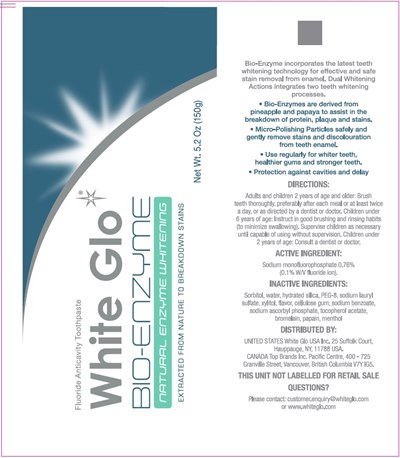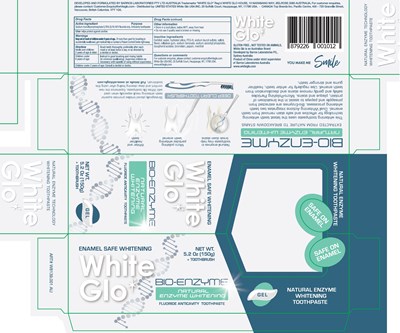Product Images White Glo Bio-enzyme
View Photos of Packaging, Labels & Appearance
Product Label Images
The following 2 images provide visual information about the product associated with White Glo Bio-enzyme NDC 73656-005 by White Glo Usa Inc, such as packaging, labeling, and the appearance of the drug itself. This resource could be helpful for medical professionals, pharmacists, and patients seeking to verify medication information and ensure they have the correct product.
Inner Package2 - Inner Package2

This is a description of White Glo's fluoride toothpaste called Bio-Enzyme which claims to incorporate teeth-whitening technology and stain removal using micro-polishing particles and enzymes from pineapple and papaya. The toothpaste aims to provide stronger teeth and healthier gums, as well as protection against cavities. The active ingredient in the toothpaste is sodium monofluorophosphate. The toothpaste is suitable for adults and children above two years of age. The text includes usage directions and a list of inactive ingredients. The product is distributed in the United States and Canada by White Glo and Top Brands Inc, respectively. The text also provides contact details for customer enquiries.*
Outer Package2 - Outer Package2

This is a description of the drug facts of a toothpaste manufactured by Barros Laboratories Pty Ltd located in Australia. The toothpaste is called White Glo and is an anticavity toothpaste that helps to protect against cavities. The active ingredient in White Glo is sodium monofluorophosphate at 0.76%. Users are warned not to use the toothpaste if the quality seal is missing or broken. White Glo toothpaste is an enamel-safe whitening toothpaste that utilizes natural enzyme technology for a bright smile. Inactive ingredients include sorbitol, PEG-8, and menthol. The toothpaste is distributed in the United States by White Glo USA Inc. and in Canada by Top Brands Inc.*
* The product label images have been analyzed using a combination of traditional computing and machine learning techniques. It should be noted that the descriptions provided may not be entirely accurate as they are experimental in nature. Use the information in this page at your own discretion and risk.